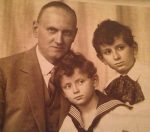Born in Gleiwitz, Germany in September 8, 1921 to Kurt Alexander Fernbach and Alice Lotte who were china and gift store merchants. He had one other sibling, Frank (Franz) Fernbach. In 1934, came to the United States as a war orphan and was adopted by Henry and Miriam Flarsheim where he adopted their family name. He fought in the Army during WWII and his military career highlights the extraordinary experience of being assigned as a German translator during the Nuremberg Trials.

He came back to the United States and attended college in Chicago School of Arts and Design in Chicago. He had a brief career in advertising and moved to Philadelphia to teach art as a college professor and artist. He married Sara Saporta and they had two sons, David F. Flarsheim and Joseph A. Flarsheim. In 1990, both sons, readopted their original family name Fernbach, translated into the English equivalent “Farbrook” and in so doing restored the family name to live on into the next generation.
In 1971, Carl remade his life that included moving to New Mexico and following a more philosophical life. I remember he struggled so much with this change and living in New Mexico was hard. He was a professor who had credentials, yet large campuses like UNM chose not to hire him. He began his own business but success was limited. Yet, he refused to return to New York. He was happy with his life for the first time since he could remember. He loved the open spaces and the landscape and he especially loved the Native American villages in the remote areas.
His artwork followed his philosophical beliefs that revolutionized his concepts of concrete poetry and his artwork showed his thoughts on the completion and conclusion of his life’s search for meaning. I remember he had his little art studio on 920 Alto Street. He would spend hours painting and producing 3-D images in large sand casts. He would say “this is what the sound of ‘WA’ looked like. This is ‘O’ and this is ‘OM.’” He would add color to the piece and say, “This is what the sound vibration looked like.” He finished his book “Conceptual Art” to which he added the final portion and renamed it “Conceptual Art and the Third Artist” and he wrote several more books before he died.
He died in 1996 in New Mexico. I was with him when he died and I felt he was finally free and happy. All his anguish and pain over the loss of his family to the Nazis, his deep feelings of being misunderstood and his successes, the family he raised in New Mexico and the illness he had lived with for so many years came to completion.
Books/Periodicals where his works can be found:
Software / Information Technology: Its New Meaning for Art: Tabloid sized exhibition catalogue published in conjunction with show held at the Jewish Museum, New York, September 16 – November 8, 1970.
The Boolean Image / Conceptual Typewriter: Project from 1970 by Carl Fernbach-Flarsheim uses a program called ‘Conceptual Typewriter’ to generate random spatial outputs of letters and numbers – taken from “SOFTWARE” exhibition catalogue.
